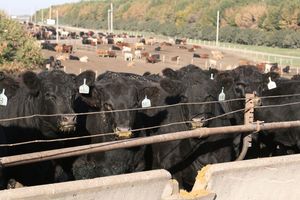Record Production, Exports Forecast for Beef, Pork, Broilers
 USDA is forecasting bullish export sales for beef, pork and poultry in 2020 and record production again in red meat and poultry.
USDA is forecasting bullish export sales for beef, pork and poultry in 2020 and record production again in red meat and poultry.
While 2019 saw record total red meat and poultry production at 105.2 billion pounds, the fifth consecutive year of increases, USDA projects red meat and poultry production will rise again in 2020 by more than 3% to 108.8 billion pounds of production, driven by record production of beef, pork and broiler meat.
CATTLE
Cattle inventory is projected to decline in 2020, following a slightly smaller calf crop in 2019. The cattle report estimates producers retained 2% fewer replacement heifers for the beef cow herd, which is projected to lower the calving numbers in 2020 as well.
Cattle imports, which rose in 2019 to 2.04 million head, are expected to rise slightly again in 2020 to 2.07 million head.
Beef production is projected to increase by 1% to a record 27.48 billion pounds. That’s supported by a larger number of cattle currently on feed and higher cow slaughter in the first quarter of the year. However, beef production will be higher in the first half of 2020, then slow in the second half of the year as cow slaughter declines. Heavier cattle weights will also support higher beef production in 2020 as well.
While beef exports fell 4% in 2019, USDA forecasts a rebound in 2020 to a record 3.3 billion pounds. USDA cited lower production in competitors such as Australia and Argentina, as well as trade agreements such as the U.S.-Mexico-Canada Agreement and trade deal with Japan and lower tariffs in South Korea as all likely to increase exports.
The five-area steer price for 2020 is forecast at $117 per cwt, close to 2019’s $116.78 per cwt. Feeder prices are forecast to average $146 per cwt, up $3.77 from 2019 prices.
PORK
The hog sector has expanded for six straight years to 2019, tying the longest expansion on record. While producers intend to farrow slightly less than 1% fewer sows in the first half of 2020, USDA still projects a larger pig crop as litter sizes continue to increase 2% to 3%. That larger litter size means USDA is again forecasting record hog slaughter in 2020.
“Despite increased slaughter capacity, timely marketings, especially in the last quarter, will be critical to preventing bottlenecks in the slaughter sector,” USDA stated.
Commercial hog production is forecast at a record 28.89 billion pounds, almost 5% higher than in 2019. Not only will there be higher hog numbers, but carcass weights also are expected to rise slightly as well.
The U.S. will see strong export demand for pork, pushing exports 17% higher in 2020 to a record 7.38 billion pounds, coming off a record year in 2019 in which exports were 6.32 billion pounds. The recent agreement with Japan will lower tariffs, while demand in China is projected to remain strong. The U.S. will also remain competitive in markets such as South Korea. Mexico will be a country to watch as increased economic growth will be important in that market, USDA noted.
Hog imports are projected at just under 5 million head in 2020, down about 2% from 2019. While Canada will increase its hog numbers, higher export demand is expected to boost Canadian domestic slaughter as well, limiting the availability of hogs for export, USDA stated.
Hog prices are projected to average $49 per cwt, up slightly from the $47.95 average for 2019.
POULTRY
Broiler production is expected to increase more than 4% to a record 45.8 billion pounds. While producers are facing pressure on margins, USDA stated producers do not appear to be slowing the pace of expansion. Weaker prices as the year goes on could eventually slow the expansion on production.
U.S. broiler exports are expected to rise 4% to a record 7.4 billion pounds as well, eclipsing record exports from 2013. “China’s announcement in late 2019 that it was reopening its market to U.S. poultry meat will also help support increased sales as the year progresses. However, chicken prices in China have not increased to the same extent as pork or beef, which may affect the competitiveness of U.S. poultry meat.”
Turkey production is also expected to increase for the first time in three years, up 1% to 5.89 billion pounds, but turkey production will remain below its peak numbers. Turkey producers are still recovering from production cuts in 2018 and 2019 due to lower prices. Turkey exports are also forecast to increase about 3% to 660 million pounds with Mexico remaining the largest destination.
FEED PRICES SUPPORT GROWTH
Livestock and poultry producers will benefit from feed prices in 2020 being slightly lower than 2019. Corn prices will remain higher in the first half of the year with the old crop, and are pegged at $3.85 a bushel. But prices will come down toward the end of the year with a larger projected corn crop for 2020, and prices will average $3.60 a bushel for the 2020-21 marketing year.
Soybean meal prices will move slightly higher, averaging $305 a ton for the old crop, but bumping up slightly to $310 a ton for the 2020-21 forecast.
Hay stocks were at 84.5 million tons on Dec. 1, 2019, an improvement over the past two years, but still well below the 2014-2016 seasons. Although stocks were higher in a number of cattle-producing states, USDA reports stocks were lower in Oklahoma, Nebraska and other Southeast states. The quality of hay is also variable.
Chris Clayton can be reached at Chris.Clayton@dtn.com
Follow him on Twitter @ChrisClaytonDTN
Source: Chris Clayton, DTN
